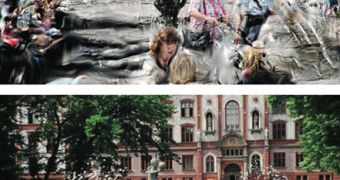Evolutionary biologists have known for quite some time that our vision is far from perfect, but a new type of optical illusion is demonstrating just how many details we can lose in this manner. The differences between perception and reality can be staggering.
Peripheral vision it the area in our field of vision that boundaries the very edge of what we can see. In some cases, this region can extend excessively, producing what is known as tunnel vision.
While many people may boast a near-perfect, 20/20 vision, even they are subjected to the limitations the image attached to this article evidences. When looking at the cross in the center of the images, people cannot observe any discernible differences between the two.
It's only when our gaze fixes on the edges of the photos that we observe a woman's head in the fountain, windows losing sharp focus and water jets becoming smudges. However, when we look exactly at the center cross, the two images look the same.
In a paper published in the August 14 issue of the top scientific journal Nature Neuroscience, experts say that this type of visual illusion shows the exact boundaries of what our eyes and our visual cues-processing areas in the brain can do.
Scientists found out a long time ago that the areas of the brain responsible for processing vision work very hard to handle the inflow of data the eyes supply. Of the five sense, vision is the most resource-consuming and intensive one, Science News reports.
For this reason, experts have always suspected that the brain has a mechanism in place that helps it filter out irrelevant information – with the added advantage of also reducing the workload needed to process a certain scene or situation.
According to New York University scientists, the brain has the tendency to ignore visual input from the periphery, opting instead to look for details and maximum accuracy in what is directly in front of us.
“Your visual system is giving you the information that you need, and it’s throwing away information that you really don’t need,” Howard Hughes Medical Institute investigator Eero Simoncelli explains.
He conducted the new study alongside NYU colleague Jeremy Freeman. “I was surprised when I would say the two things looked the same, and then see later […] that they are actually very different,” Freeman says of the illusion the team developed.
“The fact that we’re failing in these ways may sound horrible, but you have to remember that those failures aren’t affecting your ability to see or survive. You walk around just fine despite the fact that all this stuff in your periphery is jumbled,” Simoncelli concludes.

 14 DAY TRIAL //
14 DAY TRIAL //